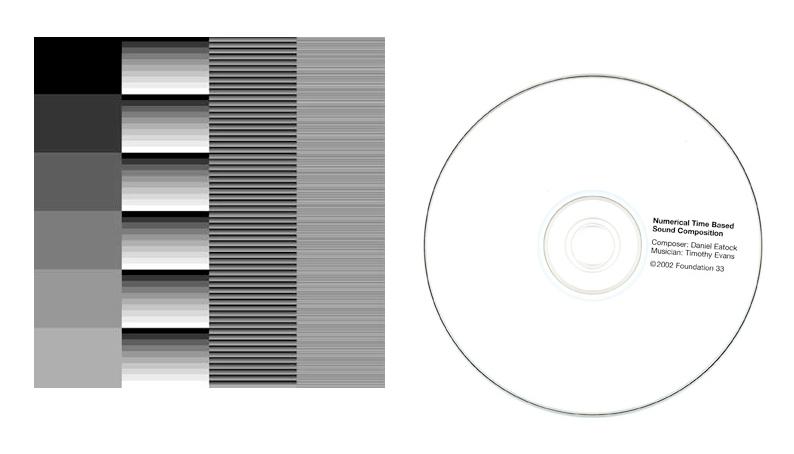Numerical Sound
Time Based Numerical Sound Composition
audio CD, 60 minutes
A digital time display counts up to one hour using four units: seconds, tens of seconds, minutes, and
tens of minutes. A numerical sound composition was constructed using the ten sequential digits: 0, 1, 2, 3, 4, 5, 6, 7, 8, 9. Each digit was assigned a tone. The tones were mathematically selected from the range of twenty to twenty thousand hertz: the two extremes audible to the human ear. The tones were logarithmically divided between the ten digits, providing tonal increments that produced a musical scale. Every second, a different combination of four tones is defined by the time counter. Above is a diagram that represents the hour-long composition.
Composer: Daniel Eatock
Musician: Timothy Evans

Numerical Sound Story
Timothy Evans
Dan came to me with a basic thought about an audio piece. The seed was planted in one of Jon Wozencroft’s ‘sound seminars’ on the RCA graphics MA course. Imagine a dull class room full of bright students being subjected to the more abstract reaches of audio art. It is easy to imagine how the mind wanders around possibilities.
Dan’s eyes became focussed on the only movement in the room; the CD player’s digital time counter. He became interested in the way the repetitive sounds occasionally aligned with the ticking of the CD counter. This reminded me of a time when I was a child passenger in a rainy traffic jam. I was also interested in how the repetitive movement of the windscreen wipers went in and out of phase with the flashing car indicators.
Dan’s question was; why not write a musical score driven by and perfectly in time with the CD time counter? It could be a dog’s bark each time the number five appeared, a whistle for number six and so on. When we started working together we agreed some further rational decisions were needed to strengthen the idea. Our excitement was in making a composition that was defined as closely as possible by the CD counter. Unlike most musical endeavours we wanted this to be mathematically precise and thoroughly objective.
A period of one hour would fit onto a standard audio CD and use the full range of the time counter. Instead of random sounds something more pure and basic was needed. We chose the simple sine wave. There are four spaces on the time display. Over an hour you can see how ten digits are used to describe the current time. We chose to use ten different frequencies, one for each digit. The frequencies span the human range of hearing.
A friend figured out the required maths to define the frequencies. Using the computer, the sixty minute composition was relatively easy to construct. Unlike previous sound projects this piece was mastered to CD without even listening to it all the way through.
Putting the disc in the player we found the idea worked perfectly. Each time a digit ticked over the frequency stepped on one notch. There are always four layers of sound so you can hear some odd effects as frequencies combine and collide.
We hope the cover design is equally pragmatic. In a similar way to the computer timeline where the composition was constructed; shades of grey represent the varying frequencies.
This project attempts to remove subjective expression from the music making process. It takes a simple idea and pushes it to logical extremes. The systematic approach functions in both audio and visual terms.
Complete, it seems the visual could never be separated from the audio. The CD was distributed with issue 5 of Dot Dot Dot magazine